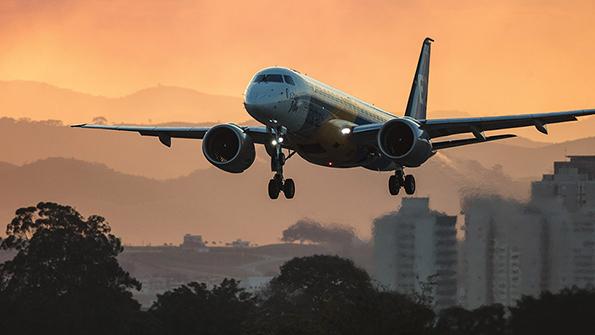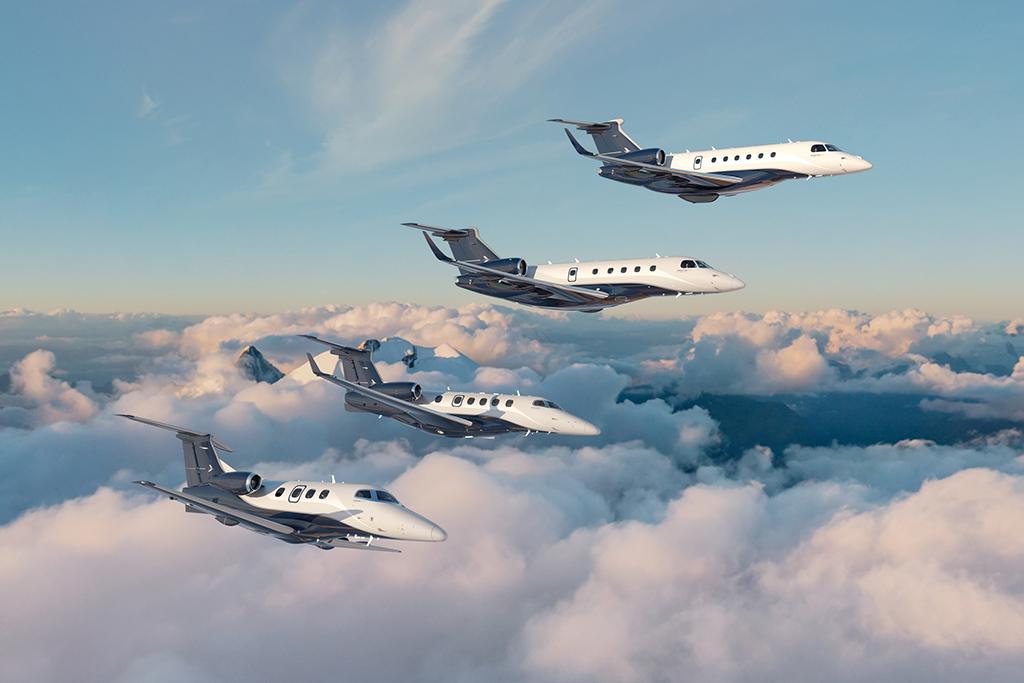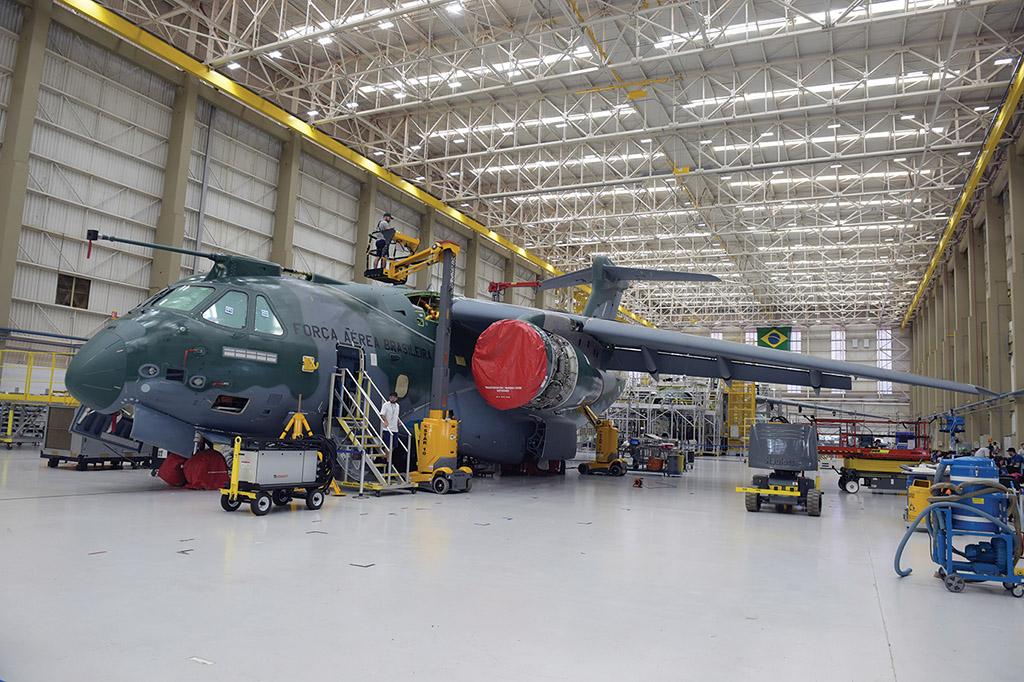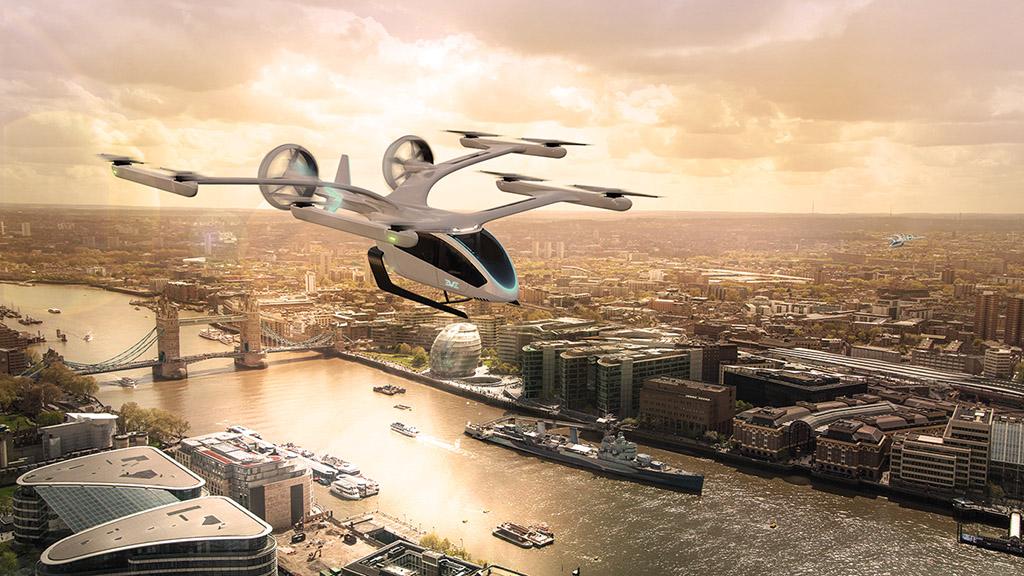
When Francisco Gomes Neto became CEO of Embraer in April 2019, he was a complete newcomer to aerospace, and the industry was in a very different place. Air travel was at an all-time high, defense tagging along as usual, urban air mobility not even in its infancy. Three years and a pandemic later, Embraer is trying to rebuild to its former position of market strength, profitability and innovation. Is it on the right path?
Looking at the fundamentals, it is hard to see why it should not be. The executive jet business is flourishing, with record sales and impressive profit margins. Defense may benefit from many governments changing their attitudes toward procurement as a fallout of the Russia-Ukraine war. Embraer has a foot in the door in urban air mobility (UAM) with its Eve affiliate, harvesting the credibility of an aircraft OEM with 53 years of experience. Most important, the Brazilian company is the only remaining manufacturer of large regional and crossover jets. With changes far beyond just reengining, its E2 family offers vast improvements over the first-generation E-Jets.
- Kickstarting E2 sales will be key to its market recovery
- Turboprop launch is slated for early 2023
- Selling more KC-390s may be difficult
Yet all is not going as well as it should for Embraer. E2 sales were already below expectations before the COVID-19 pandemic—airlines were seeking larger rather than “right-size” aircraft, in spite of Embraer’s oft-repeated mantra that smaller is more beautiful. The E175-E2 was shelved for three years and may not return, as scope clauses in the U.S. have not changed, contrary to management’s initial expectations. The E175-E1 continued to sell surprisingly well to U.S. regional carriers, but that is likely to change soon if it has not already.
With a lack of pilots to fly the current fleet, let alone additional aircraft, U.S. regional carriers’ appetite for more lift will be subdued for some time. “We may see some reduced sales for the E1,” Embraer Commercial Aviation CEO Arjen Meijer concedes. With E1 output planned to reach pre-pandemic levels over the next three years or so, there is only one conclusion: The E2 must finally take off for the growth to come back. Or as one senior industry figure puts it bluntly, “Embraer has no future if it does not sell the E2.”
With the departure of Frederico Curado (in 2016) and Paulo Cesar de Souza e Silva (in 2019), most of the generation of leaders that turned Embraer into an unlikely success story are gone. Luis Carlos Affonso, the head of engineering and strategy, is one of the few remaining members of that team still in leadership. Defense and Security CEO Jackson Schneider, on the job since 2014, is another. John Slattery, one of the strongest salesmen the industry has seen, left as CEO of the commercial aviation division in 2020 and was replaced by former sales chief Meijer, just as the industry’s worst crisis ever began.
A new team led by Neto has taken over. A year into his tenure, the planned partnership with Boeing initiated earlier by Cesar fell through. Under that plan, Boeing would have taken control of the commercial aircraft division and helped sell the KC-390 military transport. With COVID-19 halting most business activities, management finally had to hit the reset button.
Rebooting Embraer includes a five-year business plan called “fit for growth” and a broader footprint. The company’s four existing divisions—commercial aviation, defense and security, executive jets and services—will be complemented with the entry into UAM, a move some observers consider a distraction from the core business.
In Neto’s five-year plan, 2021 and 2022 are defined as the recovery period. Revenues dropped by 30% in 2020 compared to pre-pandemic levels, to $3.7 billion. They increased by 12% last year, the operating result improved by €260 million ($280 million), and the massive cash burn was stopped. The company reached $4.2 billion in sales and a $201 million operation profit, a 4.9% margin. For 2022, Embraer forecasts a 3.5-4.5% margin.
By comparison, revenues in 2016 were $6.2 billion, declining to $5 billion in 2017. The company began losing money in 2018. Embraer’s most profitable recent years were 2012 and 2013, with $612 million and $713 million in operating profits, respectively, on sales of around $6.2 billion each year.
Those years should be the benchmark against which to measure the efficiency of Neto’s plans. And 2023-26 will be characterized by “profitable and sustainable growth,” according to Neto. “We want to benefit from the recovery in commercial aviation. . . . We won’t be the biggest, but we want to be the most attractive [OEM],” he says.
“Fit for growth” consists of five pillars: increasing sales of the current product portfolio across all divisions, another deep dive into enterprise efficiency, strategic partnerships to fund new developments, innovation and environmental, social and governance (ESG) initiatives.
One might add portfolio changes as a sixth pillar, since Embraer this year concluded the sale of its composite and metallic components plant in Evora, Portugal, to Aernnova, resulting in a loss of some of its composite manufacturing capability and European industrial base. Neto decided that disposing of Evora made sense. “We did not see good utilization in Evora even for the next 10 years,” he says.
A senior industry source has another view: “If you don’t sell aircraft, you are never going to fill your factories.” He notes that Embraer has given up a large part of its industrial presence in Europe and handed over valuable know-how, particularly in composites manufacturing, to Airbus—the new owner of Aernnova, is an important Airbus supplier.
Four years into the introduction of the E2, it is clear something has to happen. At the end of the first quarter, there were just three orders remaining for the E190-E2 and 166 for the E195-E2 (see table). The first-generation E175 backlog, buoyed by demand from U.S. regional carriers adhering to scope clauses, is almost as large at 143 units. Another comparison: There were 532 outstanding orders for the Airbus A220 family, the E2’s main rival at the upper end of the market, at the end of April, three times the number of E2s.
Fifty-two E2s have been delivered—four in 2018, then 14, 11, 21 in the proceeding years, respectively, plus two this year. The expected steeper ramp-up has not materialized.
There are good reasons. In December 2017, just months before the first delivery of the first E190-E2 to Wideroe, reports emerged that Embraer might sell its commercial aviation division to Boeing. Negotiations for the deal, which were soon confirmed, dragged on until 2020, a period of uncertainty that held back potential customers from ordering aircraft.
The decision to go with Boeing divided the company not only organizationally—many functions had to be carved out and were duplicated at what remained of Embraer—but also emotionally. There were those who thought Embraer would have to join forces with a stronger group after Airbus took over the C Series program from Bombardier. That view was supported by some key customers, such as AerCap CEO Aengus Kelly and Azul Chairman David Neeleman, important industry voices.
But there was an opposing argument made by another faction in the company. “The E2 is an absolutely brilliant aircraft,” says one executive. “We got into the club, and we earned it. We had a lifetime opportunity to become a stronger No. 3.”

Then, just as it was finally certain that there would be no combination with Boeing, the pandemic essentially eradicated demand. Embraer had no choice but to go it alone, though much weakened.
The launch of what was formerly Bombardier’s C Series and subsequent launches of the Airbus A320neo and Boeing 737 MAX, forced Embraer to develop the E2 years earlier than it would have liked. The in-service E1 fleet is largely still too young to be replaced. Combine that with what one insider describes as a “brain drain,” the departure of too many experienced top executives, and all the ingredients for a crisis were there.
Yet many observers believe Embraer has reasons to be optimistic. “It is only a matter of time,” says Bank of America analyst Ronald Epstein. “They have no competition, and the regional market ebbs and flows.” Agency Partners analyst Sash Tusa says that regional airlines have been hit particularly hard by the decline in business travel, explaining the recovery lag. “This should reverse over time,” he contends.
Now, as demand appears to be returning, Embraer is experiencing the same supply chain constraints hitting other OEMs. Parked outside the F-220 final assembly hangar in Sao Jose dos Campos are two SkyWest Airlines E175s waiting for GE CF34 engines. “We could be better, but it all depends on the supply chain constraints,” says Chief Financial Officer Antonio Carlos Garcia.
But Meijer says there is reason to be optimistic: “I see a lot of traction around the globe for the E2.” That interest in the aircraft has yet to convert into more firm orders. The Farnborough Airshow in July will be an important indicator of how quickly demand for large regional jets is returning and where. Some key campaigns, such as the replacement of Lufthansa’s vast regional fleet, have not even begun in earnest. Many other large airlines, burdened by unprecedented levels of debt, are in a similar place. KLM’s large order for E2s, placed in 2018, remains the exception for the time being.
Many considerations have led the company to launch a freighter conversion program for the E1, but one of them was to free up some space for E2s. If more E1s leave the passenger fleet earlier with the opportunity to start a second life as freighters, airlines and lessors may opt to backfill capacity with the current-generation aircraft. Embraer sees a total market for around 2,800 aircraft in the 70-150-seat category over the next 10 years just for replacements.
An important milestone coming up for the E2 is delivery of Porter Airlines’ first 195-E2 this year—it will be the first of the family to be operated in North America, a market cut off by U.S. scope clauses. Meijer hopes that once U.S. airlines recognize how good the aircraft actually is, they will launch another attempt to get scope relief, at least for the smallest member of the family.
The opportunity in the freighter market is “huge.” Meijer says. That is not only because of e-commerce growth but also because of a gap in the middle of the market between small turboprops and larger narrowbody freighters such as the A321F, he notes. An initial agreement with Nordic Aviation Capital (NAC) for 10 aircraft has been signed, but Embraer is also discussing deals with other lessors. They are the natural partner for a freighter conversion, as that extends the service life of the aircraft beyond original projections. The market is expected to be 700 aircraft over the next 20 years, with 65% of them for growth.

The freighter conversion line will be set up next to the first stations in the passenger final assembly line, in a hangar underutilized since the 2020 drop in commercial jet production. Conversions of both the E190-E1 and E195-E1 will start in 2024. A portion of the additional engineering resources that Embraer is building up is allocated to the freighter project. “It was a big decision, but everything is coming together now,” Meijer says.
The much bigger decision will be whether Embraer will launch a new turboprop. The project has been in the works for several years, but its outline has become much more concrete over the past year, including a major configuration change that included moving the engines to the rear of the aircraft. Embraer is continuing discussions with engine manufacturers, and Meijer says a decision on an engine must be made by year-end for a launch in the first half of 2023.
“I have always been astonished that the market has tolerated an [ATR] monopoly for so long,” Tusa says. He sees a market for 100-150 aircraft per year, big enough to sustain competition. An element that helps Embraer could be limitations in ATR’s ability to further stretch its aircraft. Tusa points to the configuration of the landing gear in particular that would make that difficult.
“The turboprop makes sense,” Epstein says. “The technology is available; the U.S. needs a 50-seater and a turboprop is palatable with ESG criteria.” However, Epstein also raises the “big question: Who do they partner with and how do they finance it?”
In the meantime, work continues toward a launch slated for early-to-mid-2023. Wind tunnel testing of a propeller started in March in the Netherlands and will conclude in July. The turboprop and the freighter projects are the main reasons for Embraer’s plans to hire 1,000 additional engineers, essentially a doubling of its engineering workforce.
Embraer is keeping to its plans to deliver the first of the turboprops at the beginning of 2028, around two years earlier than the ATR “Evo” models, reengined and updated versions of the ATR 72 and ATR 42 (AW&ST May 30-June 12, p. 16). The company continues to plan for 70- and 90-seat versions—the latter may require a larger engine than that of the ATR. It is not yet clear which version would go first. “We get pushed in both directions,” Meijer says about talks with airlines and lessors. Whichever version comes second will come around a year later, at the beginning of 2029.
“We don’t believe hybrid or hydrogen [propulsion] will be a match fit in the next couple of years,” he says. “A conventional turboprop will be the best solution for many years to come.” Of course, the aircraft could be converted to a different energy source (much) later. “But we need to see how the technologies evolve,” he says.
For these reasons, Meijer is not concerned about the possible competition from the ATR Evo. That includes Evo’s undefined hybrid elements, which are supposed to make the engine size more optimal for cruise and so more distant from the power range Embraer requires. “It will take time for these concepts to mature. They will not be ready just a few years later,” Meijer says. “But when they mature, we will [also] consider them.”

The new technolgies will then also be applied to the Energia concept aircraft, a series of next-generation designs that are Embraer’s carbon-neutral road map. The four proposals cover 9-50 seats and include propulsion options ranging from full hybrid electric to full electric to hydrogen. The Energia aircraft could enter service in 2030-40. They would broaden rather than replace the current product portfolio. Larger aircraft, the company contends, will be powered by conventional engines using sustainable aviation fuels.
The approach is typical for Embraer. It has always nurtured strong elements of market and technology analytics—and caution—in its culture. The example of rival Bombardier’s C Series project, risking (and ultimately losing) the company, was always an unlikely option.
Partly overcoming that conservatism is an important element of Embraer’s next venture. In 2016, a group of Embraer executives paid a visit to Silicon Valley, meeting with many of its IT startups. EmbraerX CEO Daniel Moczydlower recalls being “shocked” by the meetings. “We realized we were not innovative enough. We were not taking risks high enough for new products in new markets,” he says.
The EmbraerX unit subsequently set up is meant to deal with such products and has an ambitious target. “We want to lead the revolution of the industry toward zero emissions,” Moczydlower says. Several projects emerged, such as the “Beacon” digital marketplace for maintenance, repair and overhaul services. Or Eve, spun off last year and floated on the New York Stock Exchange early this year, with Embraer remaining the controlling shareholder.
Eve more than anything exemplifies the tensions Embraer must withstand. Management sees it as an unexpectedly fast and successful jump into a new market segment, just five years after that 2016 California trip. For others, the venture is simply a distraction.
Tusa says it is very difficult for any OEM used to aviation’s typically slow production pace to scale up “to a rate 5-10 times of that.” He predicts that UAM will be a lot less financially attractive for manufacturers than they think because the customer base is fragmented and so supporting services will be extremely expensive. “Eve is a sideshow,” Tusa says. To become a serious factor, it will have to grow to the profit and cash-flow levels available to executive jets and the E-Jets in good times, he notes.
AeroDynamic Advisory Managing Director Richard Aboulafia does not see as big of a problem. “If anyone is going to have success in the advanced air mobility market, it’s going to be an established airframer, so why not?” he says. “But more likely it’s an attempt by Embraer to monetize intellectual property while there is still a rush to fund anything that says [electric vertical-takeoff-and-landing (eVTOL)].”
The initially piloted, fully eVTOL vehicle is planned to enter service in 2026. It is focused on urban, as opposed to regional, air mobility with its range of up to 100 km (62 mi.) transporting four passengers. Eve says operating costs per passenger will be six times lower than for helicopters, making it clear what the targeted market is: large urban centers such as Sao Paulo, where expensive helicopters are used to avoid often chaotic traffic on the ground.
Flight trials involving a Helisul helicopter in Rio de Janeiro to map out a potential eVTOL route are “providing the blueprint for UAM operations,” Eve Co-CEO Andre Stein says. Eve has also hired Porsche Consulting to define its manufacturing and services strategy. A full-size concept aircraft is planned to fly by year-end. Will the market take off and become worth investing in as more than a niche? Investors clearly seem to think so: Eve’s current market capitalization ($2.6 billion at the beginning of June) was significantly higher than that of its parent ($2 billion), giving the rest of the group a de facto negative valuation.
There is work to be done to establish a broader equity story that investors can trust. “We want to regain the credibility of the capital markets,” Chief Financial Officer Garcia says. And parts of the portfolio could support that effort or are even likely to do so. One of those is the Melbourne, Florida--based executive jets unit. “We had off-the-chart sales in 2021, and it continues in 2022,” Embraer Executive Jets CEO Michael Amalfitano says. “Some months are even higher.” The division plans to deliver 100-110 aircraft in 2022, compared to 60-70 from the commercial unit.
The growth in the executive jets market is “coming from the base,” Amalfitano says, rather than from the top level. Embraer has consolidated its portfolio around the Phenom and Praetor families while discontinuing the ERJ 135/145-based Legacy and E-Jets-based Lineage 1000. While the company lacks an offering at the top end of the market for long-range, larger aircraft, the current market trends are pretty well in line with its current offering. In the first quarter, the unit achieved an 18% operating margin. And that does not include the services side of the business, which Embraer has consolidated into a separate entity in a matrix function for all of its parts.
Embraer’s defense and security division, and the KC-390 military transport aircraft program in particular, has not been overwhelmed with good news recently, to say the least. The Brazilian Air Force had already reduced its original order of 28 aircraft to 22, in line with a contract clause that allows the customer to change the value 25% in either direction. But now the Brazilian government wants to reduce the order even further, to 15. Despite that, Defense and Security CEO Schneider says, “We are very optimistic about what is to come for the KC-390.”
That optimism has less to do with Brazil and a lot more to do with the Russia-Ukraine war. “Whether you like it or not, the world will not be the same after the Ukraine war,” he says. “The increase in defense budgets is here to stay,” Schneider notes as one main consequence.
Talk of exports, and procurement by any country, for Embraer’s defense products essentially stopped with the novel coronavirus pandemic, though deliveries continued based on contracts signed before the crisis. All that has changed, Schneider reports. “It is amazing how this specific market restarted after the Ukraine war,” he says. “[We have been contacted] from all corners of the world. Some countries were not even on our radar. Many countries realize that their logistics systems need to be replaced as soon as possible.”
According to Embraer data, the world’s medium-size airlifter fleet of around 1,500 aircraft is more than 30 years old on average. Needless to say, Schneider foresees an opportunity for a substantial number of export orders, beyond the original Brazilian commitment and others currently in place. “Nothing will change in the next two weeks, but you will see it in the next years,” he predicts.
Skepticism prevails among analysts, however. Tusa is “very worried” about the Brazilian Air Force’s decision to buy two Azul Airbus A330-200s for conversion into tankers. “It says for tanking you need a real tanker,” he points out. Countries aspiring to join NATO, such as Sweden, may therefore chose a large tanker common to alliance members.
Byron Callan, a defense specialist and director at Capital Alpha Partners, does not see the war in Ukraine generating a major boost in orders for the KC-390. “Maybe in Romania and some of the smaller countries,” he says. “But I’m just not ready to fully sign up for that. You don’t hear Lockheed Martin predicting a big surge in C-130 demand, or Airbus for the A400M.”
For bigger numbers, the U.S. market would be key: 56% of the medium airlifter fleet is based there. But first, Embraer is preparing the initial aircraft for delivery to the Portuguese Air Force. Portugal has signed an order for five aircraft and will get its first KC-390 in 2023. The aircraft is currently in the last position of the final assembly line at Embraer’s Gaviao Peixoto facility. It is also the first manufactured in a NATO configuration. Hungary, another NATO member state, has two aircraft on order.
Schneider says Embraer is also “at the beginning of discussing the KC-390 with India” and is looking for local partnerships “to integrate Indian solutions.”
Another major project is the engineering work for and final assembly of the Saab Gripen destined for the Brazilian Air Force. Two aircraft are currently based at Gaviao Peixoto for certification tests. With a one-year delay, final assembly of the Brazilian aircraft is planned to begin in 2023.
For Neto, it is all part of the bigger picture: “We are building a bright future for Embraer,” he says.
—With Joe Anselmo in Washington



